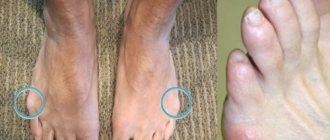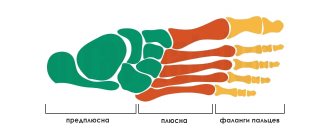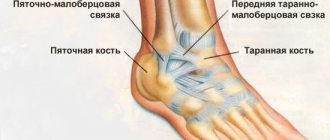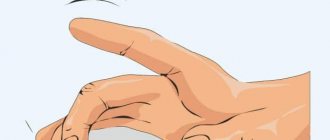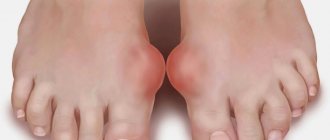The visiting day had just begun when they knocked on the office door and asked in a quiet but anxious voice: “Doctor, can I come in?” I invited her: it was a girl who, limping on her left leg, said that her little toe hurt. As it turned out, on the morning of the previous day, Marina (that was the patient’s name) was actively getting ready and, leaving the room, hit her foot on the corner of the door. But, since there was no time, she got dressed and went to work, experiencing pain and terrible discomfort the entire time. In the evening, returning home, taking off my shoes, I saw a bruise and an enlarged little finger. “Tell me, is this a fracture of the little finger?” asked Marina. “Now let’s figure it out,” I replied.
Types of pathology and causes of their occurrence
Fracture of the smallest toe can be of different nature:
- Closed or open type injury;
- Without or with displacement of bone fragments.
The type of injury is also determined by its location on a given phalanx. In the case of the foot, a fracture of the little toe can be primary, middle or nail. Moreover, violations of the integrity of the bone structure can be observed simultaneously in several places.
All causes of damage can be divided into:
- Traumatic;
- Pathological.
Most often, fractures of the pink finger occur due to traumatic reasons.
Classification
According to the classification, all fractures are divided into several types; we will describe the main ones:
- Traumatic - occur as a result of a strong mechanical shock to a bone that was previously unchanged and absolutely healthy.
- Pathological - when a fracture can occur as a result of a weak blow, but due to a pathological process in the bone itself, the bone becomes very fragile.
- Open - such fractures are accompanied by a violation of the integrity of the skin, rupture of soft tissue, which is often complicated by bleeding and infection.
- Closed – preserving the integrity of the skin.
- Complete - which in turn are divided into two types: with displacement and without displacement of fragments.
- Incomplete – this includes cracks and breaks.
A bruise is damage to superficial tissues, sometimes organs, but without significant damage to their internal structure, although there are serious changes when it comes to brain contusion.
After all the above, we have an idea of what each of the definitions means. But any diagnosis consists of the characteristics of the clinical course of the injury, so first we will touch on the symptoms.
Fracture of the little toe: traumatic
Traumatic causes of fractures include falling of various objects onto the finger, as well as impacts with furniture. This type of injury can also occur if the victim's index finger is heavily stepped on. An unfortunate fall, even on a flat surface, can also break your little finger.
Hitting furniture is classified as a traumatic cause of little finger fracture.
Most often, these injuries are of a sports nature and are observed in fans of football and other sports that require active running.
Diagnostics
It is impossible to diagnose a fracture of the little finger with 100% certainty based on symptoms, so in traumatology, X-ray examination is used to clarify the diagnosis.
The picture is taken in two projections, frontal and lateral, after which the doctor can determine that the little finger is broken and what the fracture looks like. But before determining whether it is a fracture or a bruise, it is necessary to provide first aid correctly.
Distinctive signs of a bruise
To ensure proper treatment of an injury, it is important to know how to determine if an injury is a fracture and not a bruise. And this can be done according to the following criteria:
- In case of a bruise, the finger immediately swells. In more serious injuries, swelling appears after several hours and sometimes days. Additionally, they are accompanied by bruises;
- When the integrity of the bone is broken, it is accompanied by severe pain, which intensifies when palpating the injured area. With bruises, the pain gradually subsides;
- A bruised pink toe does not change its length, but damage to the bone leads to its shortening. To determine the type of injury based on this sign, it is enough to compare the length of the little toes of both feet;
In addition, if the injury is accompanied by a bruise, the victim can not only move the foot freely, but also lean on it. With fractures, severe pain occurs not only in the area of the damaged phalanx, but spreads throughout the entire foot. This significantly impairs the ability to put weight on the foot and move freely.
There is a difference between plausible and probable. Positive findings include changes in finger size, abnormal phalangeal position, abnormal flexion of the index finger, and palpable bone fractures.
Possible symptoms indicate the presence of a pathology, which may not be a fracture, but another type of injury. Possible symptoms include fever at the site of injury, pain, limited movement, and swelling.
Briefly about the anatomy of the foot
The foot is part of the human musculoskeletal system, the part of the lower limb most distant from the body, responsible for stable position, balance, and movement of the body in space.
The foot has a flexible, elastic and movable arched design, which allows you to distribute the load on the limb, adapt to unevenness, and achieve a smooth gait thanks to the powerful ligamentous apparatus. In interaction with other parts of the leg, it is responsible for moving the body.
Twenty-six bones structurally form the three sections of the foot: the tarsus, metatarsus, and phalanges (toes).
The first section includes seven bones arranged in two rows:
- posterior – calcaneus and talus,
- anterior - navicular, three wedge-shaped and cuboid.
All of them are connected by joints, which allows a person to bend, straighten and make circular movements with the foot.
The second section is the metatarsus, consisting of five short tubular bones, located between the tarsus and the fingers.
The third section is the phalanges - tubular bones (14 pieces), connected by muscles and joints to form the five toes.
At the same time, the thumb consists of two phalanges, and the rest - of three. All of them are significantly shorter compared to the fingers, and the middle phalanx of the little finger is often inseparable from the nail. The phalanges are connected to each other by joints.
Fracture of the little toe: symptoms
A pink toe fracture almost always has obvious symptoms. In the case of an open fracture, there is a tear in the skin at the site of the fracture of the phalanx of the little finger. At the same time, a protruding piece of bone is visible through the bleeding wound. This may cause swelling of the surrounding skin. Often, open fractures of the little toe can cause swelling of the entire foot.
Symptoms of a closed fracture of the little finger are limited movement of all fingers on the limb. However, pain from an injured little toe rarely spreads to the other toes, but usually spreads to the foot area. Violation of the integrity of bone tissue is also accompanied by extensive hemorrhages, bruising the toe and the skin at its base.
Damage to bone displacement in children, young and middle-aged people is rare. Most often, this type of injury occurs in older people for pathological reasons. Such injuries are possible when heavy objects fall on the little finger. In this case, the muscles and ligaments must be stretched or torn.
One of the symptoms of a pink toe fracture is that the skin around the injury site swells quickly.
It is very difficult to visually identify a pink bone fracture that has been displaced because there is no visible visual deformation and the main symptoms are the same as for a closed fracture. When palpating the site of injury, only a faint crunch of bone fragments can be observed.
The easiest way, as recommended by doctors
According to doctors, the most common and at the same time frequently used method is tapping. If such a test is carried out correctly, in most cases it is possible to distinguish a severe bruise of the little finger from a closed fracture. To do this, you need to tap the top of your finger in the direction of its base.
If the finger is broken, then the pain will be clearly defined in the place where the bone is deformed. If the bone is not damaged, then with axial tapping, pain at the site of the bruise will not be felt.
Such a test cannot be performed if there is a suspicion of a displaced fracture or damage to the joint, since this can lead to migration of bone fragments, which can lead to the development of serious complications.
First aid
When providing first aid, consider the type of injury. In the case of an open fracture of the little finger, the first step is to disinfect the wound and stop the bleeding. To disinfect the wound, you can wash it with hydrogen peroxide, ethyl alcohol or chlorhexidine. Do not rub the wound with cotton wool or other material. To soak the edges of the wound, use only a clean cloth soaked in a disinfectant solution.
To stop bleeding, apply a sterile gauze bandage to the wound. However, if the bleeding is severe, you will need a tourniquet. Apply 15-20 cm above the wound. If a special tourniquet is not available, it can be replaced with a belt, hairband, condom, belt, or clothing torn into long strips.
Wearing a tourniquet for more than 30 minutes may cause tissue necrosis. Therefore, when using it, it is important to write down the exact time of the procedure on a piece of paper and place it under the tourniquet. If after half an hour the tourniquet has not been handed over to the healthcare professional, loosen it briefly and then re-tie it slightly higher than the previous position, being sure to note the new insertion time. Further actions correspond to first aid methods for closed injuries.
For a closed fracture of the little finger with or without displacement, first aid consists of the following measures:
- The injured limb is placed in such a position that the injured finger does not touch anything.
- If necessary, the patient may be given pain medication. Ibuprofen, Analgin, Diclofenac or Paracetamol will work.
- Apply cold air to the wounded area. To do this, wrap the cold source with a thin, clean cloth. This will avoid tissue infection if it is very cold or if there is very little damage to the skin.
If the little finger is broken, the pain reliever Ibuprofen can be prescribed.
In case of violation of the integrity of bone tissue with displacement, an immobilizing bandage must be applied to the damaged finger. In the absence of special medical splints, it is enough to wrap the little finger with a bandage around the adjacent ring finger.
Is it possible to walk
If the little finger is fractured, the patient is advised to lie in bed more. Stepping on or moving on a broken limb is strictly prohibited. Do not forget that the patient's physical activity will be minimal. Therefore, he may become constipated. Carrots, beets, cabbage, and coarse fiber products help to avoid it. They improve the functioning of the gastrointestinal tract.
Types of orthopedic devices used for a broken finger
A patient with a broken toe needs to wear a plaster cast. It is worn for 2-3 weeks. There are also special orthopedic products that help fix the injured limb. This:
- A semi-rigid device that secures the foot on both sides. It is made from very dense material. It is attached to the leg with special tight fasteners.
- Hard bandage. It is worn in case of a displaced leg fracture. This device has special fasteners. They securely attach the toe when the little toe is fractured and provide proper tension to the foot.
Fracture of the little toe: treatment methods
The main treatment for a pink toe fracture is to rest it for an extended period of time to allow the bone to heal. To do this, a special immobilizing bandage is applied to the injured finger - a splint. For this you can also use a tight bandage and plaster fastening. However, it is used only when the main and middle phalanges are damaged. If the nail phalanx is damaged, it is immobilized by applying several plasters.
In most cases, until the bone is completely healed, you can wear special splints to immobilize only the injured finger.
The length of time you wear braces or a cast depends on the nature of the injury and the healing time of the damaged bone tissue. This process usually takes about 1 month. However, a week after applying the bandage, it is often necessary to examine and x-ray the finger. This is necessary to avoid improper fusion of bones during shifts.
Open fractures, as well as injuries with dislocations, are treated surgically. During surgery, the fragments are removed and the bone is returned to its natural position. Thin dowels or, less commonly, steel plates are used to hold them in place. After connecting the bone, the supporting elements are removed.
Rehabilitation (duration)
Rehabilitation is carried out only after complete healing of the broken bone. It includes the following actions and procedures:
- Physiotherapy. These could be sessions of electrophoresis, magnetic therapy, quartz treatment;
- Massotherapy;
- Visit to the physical therapy room (PT).
Rehabilitation after a fracture of the little finger includes therapeutic massage.
What to do after a fracture of the little toe is decided by the doctor, based on the nature of the injury and the duration of treatment. The foot muscles have a greater need to regain their function because they have been limited in movement for a long time and have become less flexible. A noticeable improvement in the condition of muscle tissue occurs after 5-7 sessions of the chosen therapeutic course. The duration of rehabilitation depends on the characteristics of the human body. Typically, return to full fitness occurs after 4-6 weeks of rehabilitation treatment.
Recovery
During rehabilitation, the patient will also have to follow the following simple rules:
- Perform therapeutic exercises developed by your doctor.
- Go for a massage to a specialist and perform it at home. Massage with warming oils. They accelerate the flow of blood and nutrients to the injured limb and speed up rehabilitation.
- Get rid of highly salted foods, bread, flour products, sweets. These products slow down metabolism, settle in the kidneys, and increase the patient’s weight.
Physiotherapy
Physiotherapeutic procedures also help speed up the healing process. Used:
- UHF. They have an analgesic effect on the body, help remove swelling, and improve blood circulation.
- Magnetotherapy. It is carried out with devices that emit a useful magnetic field. Moreover, the procedures are carried out directly through a plaster cast. Such procedures speed up the process of bone fusion after surgery.
- Electrophoresis. It is used when the patient has severe pain. With the help of the device, the cells of the drug better penetrate into the tissues and improve all processes.
- Interference currents. They also speed up the healing process of a broken finger. The procedure is carried out with 4 electrodes, which are connected directly to the patient. A current of 100 Hz is supplied through them. This device has an analgesic effect and helps remove swelling.
Remember: if a patient, after a broken finger, has a dense tumor at the site of injury, then he should visit a massage therapist’s office. He can also give himself a massage at home on his own. But you shouldn't do it too much.
This will allow the bone fragments to move further away from each other.
Physiotherapy
After keeping the finger in a bandage for a long time, the patient’s motor activity sharply decreases. The following simple set of exercises helps restore it. This is how it is done. Patient:
- Sits on a chair and makes rotational movements with his feet.
- Collects pencils directly from the floor into a box. This exercise improves body coordination and restores the previous performance of the muscular system.
- Spreads the fingers of the injured limb. Remember: there should be no pain. If it appears, then the exercise should not be done.
To summarize: injury to a small toe is not as harmless as it seems at first glance. It is important that the patient does not diagnose himself or try to cure himself. Such actions can be very dangerous and will lead to serious illnesses. It is better to entrust your body to an experienced doctor in this matter, who will help get the patient back on his feet quickly.
Possible complications
If medical care is not provided on time or is neglected, injuries can trigger the development of various complications:
- Abnormal bone fusion;
- Formation of a false phalanx;
- The occurrence of purulent processes in inflamed tissues. Often occurs with open fractures as a result of infection in diseased tissue.
In rare cases, a bloodstream infection may develop. However, most complications can be prevented or eliminated by seeking timely medical attention.

